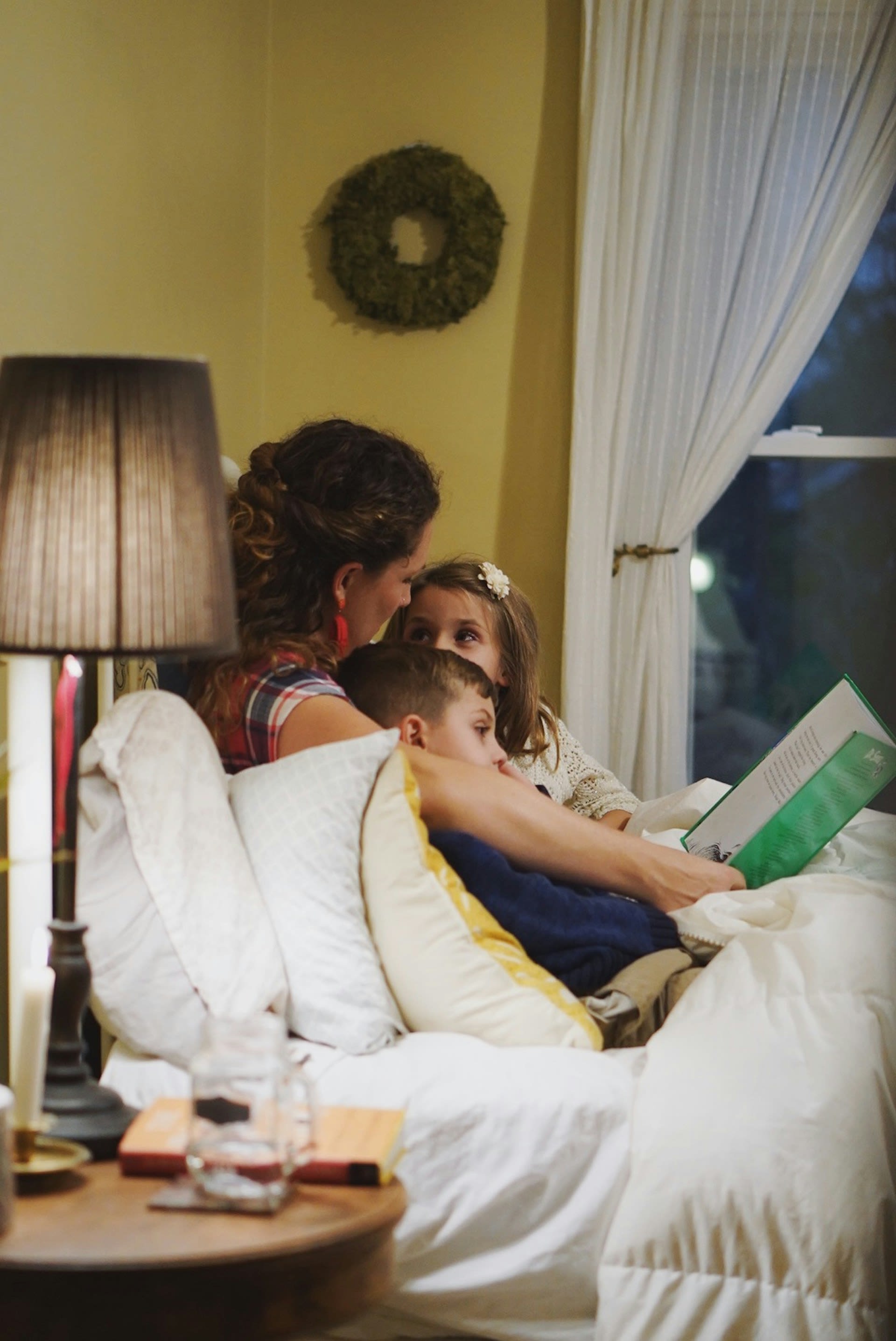In the intricate tapestry of parenting, ensuring your child receives a good night's sleep is one of the most crucial threads, intricately woven into their overall well-being and development. Sleep, often undervalued and overlooked, is as critical to children's growth as nutrition and exercise.
From establishing a calming bedtime routine to understanding the science of sleep, this guide is designed to arm parents with practical strategies, insights, and encouragement. It aims to transform bedtime from a nightly challenge into a peaceful retreat, fostering an environment where every child can thrive in a realm of dreams, waking up refreshed and ready to embrace the day.

What Are the Recommended Sleep Durations for Children?
The National Sleep Foundation provides guidelines on the recommended amount of sleep for children of different ages. Getting the proper sleep duration is crucial for a child's physical health, cognitive development, and emotional wellbeing.
For newborns 0-3 months, 14-17 hours of sleep per 24 hours is recommended, including naps. Infants 4-11 months should get 12-15 hours of sleep in a 24 hour period.
Toddlers ages 1-2 need 11-14 hours of sleep total per day, while preschoolers ages 3-5 require 10-13 hours. For school age children 6-13, the guidelines recommend 9-11 hours of sleep per night.
Teenagers ages 14-17 have slightly decreased sleep needs, at 8-10 hours per night. However, teens tend to have delayed circadian rhythms, meaning they naturally feel more alert later at night and prefer to wake up later.
While these are general recommendations, individual sleep needs can vary. It's important to watch for signs of sleep deprivation in children and adjust bedtimes accordingly. Sleep consistency also matters - aim to stick to a regular bedtime and wake-up schedule, even on weekends.
Establishing a Consistent Bedtime Routine
A consistent bedtime routine is crucial for helping children develop healthy sleep habits. Having a predictable sequence of relaxing activities before bed makes it easier for children to wind down and fall asleep.

Establishing a regular bedtime also regulates their circadian rhythm so their bodies learn when it's time to sleep.
There are many benefits to a consistent bedtime routine:
-
It signals to a child's body that it's time to sleep. Doing the same activities in the same order each night strengthens this sleep cue.
-
Routines create a sense of security and comfort. Familiar activities are soothing and help children emotionally prepare for sleep.
-
Routines lead to better sleep quality. Having a calming transition to bed makes it easier for children to fall asleep faster.
-
Routines teach good habits. Following a nightly schedule helps children build self-regulation and responsibility.
Some good activities to include in a bedtime routine are:
-
Taking a warm bath which helps lower body temperature for sleep.
-
Getting into pajamas signals it's time for bed. Comfortable sleepwear helps children relax.
-
Reading bedtime stories together is a bonding experience and gets children feeling sleepy.
-
Dimming lights in the bedroom makes the brain start producing melatonin.
-
Playing soft, calming music sets the stage for sleep.
-
Practicing meditation or breathing exercises relaxes the mind and body.
-
Giving a gentle massage helps soothe and unwind children.
Pick a regular bedtime that allows for the recommended hours of sleep and aim to stick to it consistently, even on weekends. Having a regular sleep schedule regulates the body's clock and leads to better quality rest.

Creating a Sleep-Friendly Environment
A child's bedroom environment can have a major impact on their sleep quality and ability to fall asleep. Here are some tips for optimizing your child's sleep environment:
Temperature
-
The ideal temperature for your child's bedroom is around 65-70°F (18-21°C). This cool environment helps facilitate the natural drop in core body temperature that occurs during sleep.
-
Use breathable blankets and lightweight pajamas to prevent overheating. Flannel sheets and warm pajamas are cozy in the winter but can lead to night sweats and restlessness.
-
Consider using a fan or opening a window at night to keep air circulating. Stagnant, stuffy air can disrupt sleep.
Lighting
-
Blackout curtains or shades are ideal for blocking outside light that may wake your child up earlier than desired. Light exposure can disrupt circadian rhythms.
-
Install dimmer switches to control the lighting and avoid bright overhead lights at bedtime. Soft lighting helps cue the brain that it's time for sleep.
-
Eliminate sources of light like TVs, computers, and smartphones from the bedroom. Cover or remove electronic displays.
Noise
-
White noise machines, fans, or ambient sounds can help drown out disruptive noises and create a soothing environment.
-
If possible, choose a quiet room away from household noises for your child's bedroom. Sound machines can mask noises like snoring siblings or pets.
-
Thick rugs, curtains, and furniture can help absorb noise and echoes. Avoid noisy nighttime activities near bedrooms.
Bedding
-
Choose a high-quality mattress that provides comfort and support for your child's growing body. Replace mattresses every 5-10 years.
-
Breathable sheets and lightweight blankets help prevent overheating. Natural fabrics like cotton allow more airflow.
-
Comfortable, stretchy pajamas can make sleeping more restful. Avoid fabrics that are too warm or that restrict movement.
The Importance of Healthy Sleep for Development
Sleep is absolutely crucial for a child's growth and development. During sleep, important restorative processes occur that allow a child's brain and body to develop properly. Getting inadequate sleep can have significant impacts on a child's behavior, mood, learning, and overall health.
Lack of sleep is linked to difficulties with emotional regulation, leading to increased irritability, tantrums, and mood swings. Sleep-deprived children often have trouble paying attention, learning new information, and performing academically. Even losing 1-2 hours of sleep can affect memory, focus, and cognitive function.
Signs that a child is not getting enough sleep include:
- Difficulty waking up in the morning
- Daytime sleepiness and lethargy
- Hyperactivity and behavioral problems
- Lack of enthusiasm for normal activities
- Dark circles under the eyes
- Changes in appetite
Children who get enough high-quality sleep are more likely to have a positive attitude, healthy social relationships, and the focus to learn new skills.
Most experts recommend that preschool-aged children should get between 10-13 hours of sleep per day, including naps. School-aged children require 9-12 hours of sleep per night. Quality naps can help younger children function at their best. Most children can stop napping between ages 3-5. Napping too close to bedtime or for too long can interfere with nighttime sleep.
Establishing healthy sleep habits early in childhood is crucial for supporting growth, behavior, mood, and success in school. Make sleep a priority to help children thrive.
Encouraging Good Sleep Habits
As a parent, you play a pivotal role in nurturing healthy sleep habits in your children from an early age. By modeling good sleep hygiene yourself and using positive reinforcement, you can help establish routines that will benefit your child throughout their development.
It's important to lead by example when it comes to sleep. Make sure you are well-rested, have a consistent bedtime routine, and avoid screens before bed. Children pick up on their parents' habits, so setting a good example is the first step.
Use positive reinforcement when your child demonstrates good sleep behavior. Praise them for cooperating with their bedtime routine, staying in bed overnight, or waking up at an appropriate time. This positive feedback helps motivate them to repeat that behavior. You can also consider using a reward system with small treats or privileges to encourage sleep success.
Being consistent is key when establishing healthy sleep patterns. Set the same bedtime and wake-up time each day, including weekends and holidays. Follow the same sequence of calming activities before bed each night. Consistency helps cue the brain and body that it's time for sleep. Children thrive on routines, which provide a sense of security and predictability at bedtime.
Stick to the schedule as often as possible. If adjustments are needed, make them minimal and gradually. With time and consistency, the healthy habits you establish will become second nature for your child. Sweet dreams will follow!
Nutrition and Sleep
What children eat and drink before bedtime can have a big impact on the quality of their sleep. Having a light, healthy snack before bed may help prevent disruptive hunger during the night. Some good options include whole grain cereal, yogurt, bananas, or peanut butter on whole wheat toast. These provide a mix of protein and complex carbs to help kids feel satisfied. Avoid sugary or heavily processed snacks, which can cause energy crashes later.
It's also wise to avoid caffeine for several hours before bedtime. Caffeine is a stimulant that can make it harder for children to fall asleep and stay asleep. Most experts recommend stopping caffeine intake by early afternoon. Sources like chocolate, soda, tea, and coffee should be limited, especially in the evening.
Proper hydration is important as well. Dehydration can exacerbate sleep issues like snoring or sleep apnea. Make sure kids drink enough water through the day and have a glass within 1-2 hours of bedtime. But limit fluid intake right before bed to avoid middle-of-the-night bathroom trips. The best bet is to stop drinking 30-60 minutes before lights out.
Establishing healthy sleep nutrition habits from a young age is key. The right balance of snacks, caffeine avoidance, and hydration can go a long way in promoting more restful slumber for growing kids.
Physical Activity and Sleep
Engaging in regular physical activity is an important component of healthy sleep habits in children. Physical activity has a number of benefits when it comes to promoting higher quality sleep:
-
Exercise helps children sleep more soundly and deeply at night. Moderate to vigorous activity during the day leads to greater feelings of fatigue at bedtime. This helps children fall asleep faster and stay asleep.
-
Physical activity improves sleep duration. Children who are more physically active tend to sleep longer than less active peers. Even light exercise is linked to more total sleep time.
-
Exercise may boost sleep quality. There is some evidence showing that physical activity increases time spent in deep, restorative stages of sleep. This leads to feeling more refreshed upon waking.
-
Activity helps regulate the body's circadian rhythm. Being active during the day strengthens the sleep/wake cycle and can make it easier to fall asleep at the appropriate time.
To maximize these benefits, physical activity should be timed properly around bedtime. Exercise should take place earlier in the day or afternoon, at least 3 hours prior to bed. Exercise late at night can overstimulate the body and make it harder to wind down before bed. Strenuous activity too close to bedtime can also elevate heart rate, body temperature and stress hormones - all of which are counterproductive to falling asleep.
Instead, the hour before bed should be reserved for calm, relaxing activities to transition into "sleep mode". Things like taking a warm bath, listening to soothing music, reading a book, or doing gentle stretches are good options. Avoiding overstimulation from high-energy play, sports, or vigorous exercise in the evenings will set children up for better sleep at night.
Managing Common Sleep Problems
Bedtime struggles and sleep issues are common challenges many parents face. By understanding the causes and implementing positive strategies, you can help your child overcome problems and get the rest they need.
Dealing with Bedtime Resistance
It's natural for kids to try delaying bedtime, but giving in to pleas for "just a few more minutes" can reinforce bad habits. Have a set bedtime and stick to a calming routine. Avoid scolding or getting visibly upset. Stay patient, keep directions brief, and use rewards like an extra story for cooperation.
Addressing Nightmares
Scary dreams are normal, but frequent or severe nightmares can disrupt sleep. Provide comfort when they occur. Discuss dreams calmly in the morning and relate them to daily events. Ban scary movies/stories before bed and encourage expression through drawing. Consider professional help if nightmares persist.
Managing Bedwetting
Bedwetting is common until age 7. Reduce fluids before bedtime, take bathroom breaks, use nightlights, and employ mattress covers. Reward dry nights, not punish wet ones. See a doctor if it continues beyond 7 to rule out underlying issues. Medication or bedwetting alarms may help.
Getting Professional Help
Consult your pediatrician if sleep problems like frequent night waking, loud snoring, or sleepwalking occur. They can check for larger issues like sleep apnea. A sleep specialist can help assess sleep disorders. Behavioral therapy is also effective for bedtime troubles. Sleep coaches can aid in establishing routines.
Sleep and Technology
Technology plays an increasingly large role in children's lives from a young age. While devices like phones, tablets, and TVs can have benefits, they also have the potential to disrupt healthy sleep when used before bedtime. Limiting and thoughtfully managing technology and screen time is an important part of promoting good sleep habits.
One of the biggest things parents can do is set limits on screen time before bed. Experts generally recommend avoiding electronics in the 1-2 hours before bedtime. The blue light emitted from screens can suppress melatonin production and make it harder to fall asleep. Setting a consistent cutoff time for technology at night helps signal to the brain that it's time to start winding down.
Removing devices like phones, tablets, and TVs from the bedroom is also beneficial. Having tech around can tempt kids to keep engaging with it when they should be sleeping. Keeping the bedroom a technology-free sanctuary helps set the stage for better rest. Consider a centralized tech charging station in another area of the home.
There are also options like blue light blocking glasses that can help reduce some of the sleep-disrupting effects of tech devices. While less research has been done on their efficacy in children, they may be worth considering as part of an overall healthy tech routine. Apps like f.lux that reduce blue light on devices at night are another option.
Like any habit, limiting tech and establishing positive technology routines takes time and consistency. But doing so can pay off tremendously in your child's sleep quality and ability to fall asleep easily. Maintaining balance between the benefits and drawbacks of technology helps ensure kids reap the most rewards.
Sleep Tips for Children with Special Needs
Children with special needs such as ADHD, autism, sensory processing disorder, and other conditions may face unique challenges when it comes to sleep. Their needs differ from neurotypical children, so parents must tailor sleep strategies accordingly.
Sleep Issues in Special Needs Children
Children on the autism spectrum tend to have higher rates of insomnia, sleep anxiety, bedtime resistance, and daytime sleepiness. Those with ADHD also struggle with insomnia and have a hard time settling down at night. Sensory sensitivities, gastrointestinal issues, and sleep disorders can further disrupt sleep.
Adapting the Sleep Routine
Creating structure, predictability, and positive associations around bedtime is key. Use picture schedules to outline the routine visually. Simplify the steps and allow extra time for transitions. Incorporate calming sensory tools like weighted blankets. Avoid overstimulation and stick to quiet activities before bed.
Adapting the Sleep Environment
Tailor the bedroom to suit the child's needs. Some benefit from minimal stimulation, while others sleep better with background noise. Address sensory issues with lighting, textures, and scents. Allow comfort items and find bedding that provides needed pressure.
Seeking Medical Guidance
Talk to doctors about any sleep disturbances, and have the child assessed for underlying issues. Sleep studies can check for apnea and restless leg syndrome. Melatonin supplements may help under a doctor's direction. Occupational therapy can also address sensory needs around sleep. Don't hesitate to seek outside support.
With some adjustments to sleep routines and environments, children with special needs can develop healthier sleep habits for better days ahead. Stay patient, flexible, and consistent when tackling sleep challenges.
Conclusion
As our exploration of nurturing better sleep in children draws to a close, we're reminded of the profound impact sleep has on our children's lives. It influences their learning, mood, health, and so much more.
By following this guide, you're not just ensuring your child gets enough rest—you're laying the groundwork for their overall success and happiness.
Remember, fostering good sleep habits is a journey, unique to every family. Patience, consistency, and love are your best tools on this path.
So, as you turn off the lights and close the door each night, take comfort in the knowledge that you're not just giving your child the gift of sleep but the endless benefits that ripple out from it. Good night, sleep tight, and may your parenting journey be as rewarding as it is restorative.



